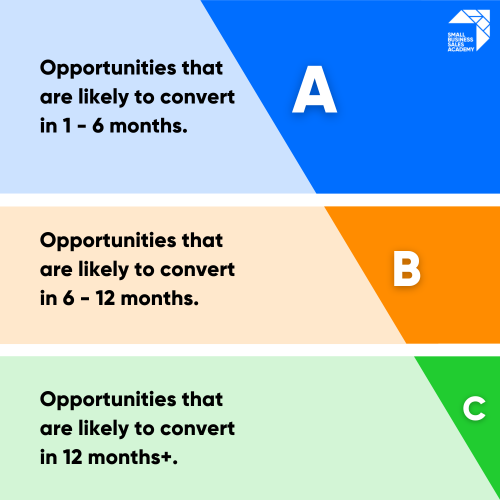One of the key challenges that business leaders face is getting their sales teams to win business now while also doing the right work in their pipeline to maintain it for future months and quarters.
If you only focus on the short-term, you could resort to some desperate measures to win the business such as discounting or appearing pushy or desperate in a sales meeting.
If you only focus on the long-term, you’re going to face short-term issues with no sales coming into the business, leaving you short of hitting targets for the month or quarter.
How can you ensure your team deliver in the short term whilst also looking after the long term?
Here’s a simple method that you can roll out with your team to ensure that they focus on achieving short-term success whilst also nurturing a healthy long-term pipeline for future conversions.

Step 1
Take a look at the average sales cycle that you have: a sales cycle is the length of time it takes from meeting someone to doing business with them. In many cases for businesses who sell to other businesses, this can be a few months.
Step 2
Use the structure above, (An ABC meeting block structure) based on your average sales cycle timeline to focus your team’s time with potential clients on a weekly or monthly basis. If your sales cycle is short, you’re A blocks might be 1-3 months but if your sales cycle is longer, you’re A blocks might be 3-6 months.
Step 3
Ask your team to record details of what meetings/calls they are having and in what category the prospect falls into so that you can support them to do both short and long term sales work:

Block A
These are all prospecting activities with prospects/clients that you expect would result in a completed deal in 1 – 6 months.
These prospecting activities may include meetings, conversations, phone calls or appointments.
Block A prospecting is important for short-term goals and your team should be spending half of their time with these types of prospects/clients.
Block B
These are all prospecting activities with prospects/clients that you expect would result in a done deal in 6 – 12 months’ time.
These are prospects/customers who are not really ready to buy now, and work is needed to move them through the sales funnel.
We recommend that your sales team spend 2/6 of their time prospecting in this block.
This is a medium-term goal and it will ensure that by focusing some of their time in Block B, your medium term pipeline is being looked after.
Block C
These are all prospecting activities with prospects/clients that you expect would result in a done deal in 12 Months+.
These are prospects/customers who are nowhere near ready to buy and nurturing is needed to move them through the sales funnel.
We recommend that your sales team spend only 1/6th of their time prospecting in this block.
Many salespeople like to focus on having meetings and perhaps spend more time in the B & C blocks even though this is not going to result in business anytime soon. By implementing this method and then reviewing with your sales team the plans that they have for that day/week, you can be assured that they are spending time in the right income-generating areas.
I often see salespeople trying to justify C meetings or trying to hide C meetings as A meetings. Here are some simple questions you can ask to clarify or get a better perspective of what category a potential client is in:
- Have they already done business with you before?
- Who are they meeting and what is their position/role?
- What is driving the prospect to buy within the next 6 months?
- What evidence do you have to support them buying in the next 6 months?
- What is driving that timeline for the buyer?
- Why is it so critical that it gets done in the 1 – 6 month period?
By asking these and other questions, you can start to ensure that your sales team’s time (which is the most precious commodity they have) is being spent in the right areas.
It’s important to encourage the team to have A, B and C prospect/client meetings in a proportionate way. Spending too much time on A may give you a good month now, but what is going to happen next month? Spending too much time on B and/or C will mean they won’t reach their monthly target and they won’t earn what they want to. Either way, not prospecting in a proportionate way will simply cause problems.
I hope that you find this method a simple way to help your sales team utilise their time more effectively, and for them to get clarity on who they should be meeting with, when and why.
A final note
Your sales team should love this approach! Ultimately, they earn when they bring business in. Prospecting in this way will ensure they are setting themselves up to be rewarded consistently.
Share this graphic with your team and start planning your future meetings with A, B & C blocks to ensure you meet your monthly/quarterly targets.
